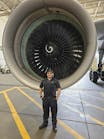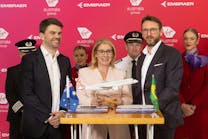Lufthansa Group Reach an All-Time High in 2017
In December, the airlines of the Lufthansa Group welcomed approximately 9.3 million passengers. This displays an increase of 19.9 percent compared to the previous December. The available seat kilometers increased 14.2 percent over the previous year and, at the same time, sales increased by 15.9 percent. The seat load factor improved accordingly, rising 1.1 percentage points compared to December 2016, to a sum of 78.9 percent. In total, the airlines of the Lufthansa Group welcomed around 130 million passengers on board their aircraft in 2017 and with this number, set a new passenger record. The seat load factor on the 1.1 million flights last year remained at a record high of 80.9 percent.
The currency adjusted yield indication continued to develop positively throughout December.
Cargo capacity increased 6.6 percent year-on-year, while cargo sales were up 5.8 percent in revenue ton-kilometer terms. As a result, the Cargo load factor decreased 0.5 percentage points in December. Overall, the cargo capacity in 2017 was 3.3 percent higher than in the previous year. At the same time, cargo sales in this period increased by 7.4 percent, resulting in a load factor of 2.7 percentage points greater than in 2016.
Network Airlines
The Network Airlines (Lufthansa German Airlines, SWISS and Austrian Airlines) carried seven million passengers in December, 7.4 percent more than in the prior-year period. Compared to the previous year, the available seat kilometers increased by 4.5 percent in December. The sales volume was up 5.8 percent over the same period, raising seat load factor by 1 percentage point to 78.7 percent. In 2017, the Network Airlines carried 97.4 million passengers, and therefore 6.8 percent more than in the previous year. During this period, the seat load factor for Network Airlines increased by 2.1 percentage points to 81.1 percent.
Lufthansa German Airlines transported 4.7 million passengers in December, a 7.3 percent increase compared to the same month last year. A 4.2 percent increase in seat kilometers in December corresponds to a 5.1 percent increase in sales. Furthermore, the seat load factor was up to 79.2 percent, a total of 0.7 percentage points above the prior-year’s level. In 2017, Lufthansa German Airlines carried 66.2 million passengers, 6.1 percent more than in the previous year. At 81.6 percent, the seat load factor was 2.5 percentage points higher than in 2016.
Point-to-Point Airlines
The Lufthansa Group’s Point-to-Point Airlines – Eurowings (including Germanwings) and Brussels Airlines – carried around 2.4 million passengers in December. Among this total, 2.1 million passengers were on short-haul flights and 251,000 flew long-haul. This amounts to an increase of 80.3 percent in comparison to the previous year. December’s capacity was 107.2 percent above its prior-year level, while its sales volume was up 113 percent, resulting in an increased seat load factor of 2.2 percentage points to 79.4 percent.
On short-haul services, the Point-to-Point Airlines raised capacity 77.7 percent and increased sales volume by 90.1 percent. This resulted in a seat load factor increase of 5.0 percentage points compared to December 2016, totaling to 77.0 percent. The seat load factor for the long-haul services decreased 5.7 percentage points to 82.7 percent during the same period, following a 170.1 percent increase in capacity and a 152.8 percent rise in sales volume, compared to the previous year.
The Point-to-Point Airlines carried a total of 32.6 million passengers in 2017, 77.0 percent more than in the previous year. At 79.9 percent, the seat load factor was 0.3 percentage points higher than in 2016.


